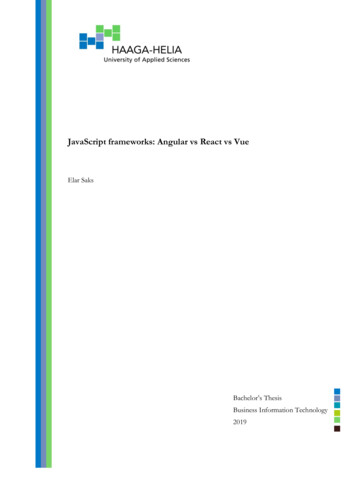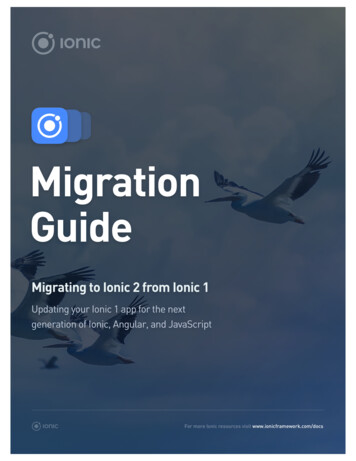
Transcription
Reactive Applicationswith Angular 2
Understand how tobuild fully reactivefeatures in Angular 2
The Reactive Big PictureObservables and RxJSAgendaImmutable OperationsReactive State and @ngrx/storeReactive AsyncReactive Data Models
The Reactive Sample Project A RESTful master-detail web application thatcommunicates to a local REST API using json-server A reactive master-detail web application that uses@ngrx/store We will be making the widgets feature reactive Feel free to use the existing code as a reference point Please explore! Don't be afraid to try new things!
http://bit.ly/fem-ng2-ngrx-app
http://onehungrymind.com/fem-examples/
Pre-Challenges Download and run the sample application Wire up the widgets component to the widgets-list andwidget-details components via @Input and @Output Connect the widgets service to communicate withRESTful api using the HTTP module andObservable.toPromise
The Reactive Big Picture
The Reactive Big Picture The Reactive Sample Project Angular History Lesson Why Reactive? Reactive Angular 2 Enter Redux
Angular History Lesson
Hello Angular 1.x
Let's Get Serious
Let's Get Realistic
Two Solid Approaches
Named Routes
Directives
Components
Small Problem
State Everywhere!
We need a better wayto manage state
What if we only had tomanage state in ONE place?
What if we could RELIABLYpush new state to our app?
What if we coulddramatically SIMPLIFYhandling user interactions?
Why Reactive? In the context of this workshop, reactive programmingis when we react to data being streamed to us overtime The atomic building block for this is the observableobject which is an extension of the Observer Pattern
Observer Pattern
Iterator Pattern
Observable Sequence
ONOUSPromiseObservableTime Value
ervableValue Consumption
Reactive Angular 2 Observables are a core part of Angular 2 Async pipes make binding to observables as easy asbinding to primitives Observables and immutability alleviate the burden ofchange detection
this.http.get(BASE URL).map(res res.json()).map(payload ({ type: 'ADD ITEMS', payload })).subscribe(action this.store.dispatch(action));Observable Sequence
div class "mdl-cell mdl-cell--6-col" items-list [items] "items async"(selected) "selectItem( event)" (deleted) "deleteItem( event)" /items-list /div div class "mdl-cell mdl-cell--6-col" item-detail(saved) "saveItem( event)" (cancelled) "resetItem( event)"[item] "selectedItem async" Select an Item /item-detail /div Async Pipe
Enter Redux Single, immutable state tree State flows down Events flow up No more managing parts of state in separatecontrollers and services
Redux is a library but moreimportantly it is a pattern
Required ViewingGetting Started with Redux by Dan ith-redux
Single State Tree
State Flows Down
Events Flows Up
All Together Now!
Demonstration
Challenges Download and run the sample application Identify the major reactive components Where are we using observables? Where are we using async pipes?
Observables and RxJS
Observables and RxJS Reactive with Observables Data Flow with Observables What is RxJS? RxJS and Observables Most Common RxJS Operators Async Pipes
Reactive with Observables In the observer pattern, an object (called the subject),maintains a list of its dependents, called observers, andnotifies them automatically of any state changes,usually by calling one of their methods. This represents a push strategy as opposed to a pull(or polling) strategy An observer doesn’t have to constantly poll the subjectfor changes, the subject “pushes” notifications to theobserver
RxJS What is RxJS? RxJS and Observables Most Common RxJS Operators RxJS Examples
What is RxJS? A set of libraries to composeasynchronous and event-basedprograms using observable collections A TON of operators that allow youtransform an observable stream This is generally where the learningcurve gets steep
Required ReadingReactive Programming with ogramming-with-rxjs
/* Get stock data somehow */const source getAsyncStockData();const subscription source.filter(quote quote.price 30).map(quote quote.price).subscribe(price console.log( Prices higher than 30: {price} ),err console.log( Something went wrong: {err.message} ));/* When we're done */subscription.dispose();Basic Example
Marbles
Most Common RxJS Operators testflatMap
// Arrayvar numbers [1, 2, 3];var roots numbers.map(Math.sqrt);// roots is now [1, 4, 9], numbers is still [1, 2, 3]// Observablevar source Observable.range(1, 3).map(x x * x);var subscription source.subscribe(x console.log('Next: ' x),err console.log('Error: ' err),() console.log('Completed'));//////// Next: 1Next: 4Next: 9Completedmap
// Arrayvar filtered [12, 5, 8, 130, 44].filter(x x 10);// filtered is [12, 130, 44]// Observablevar source Observable.range(0, 5).filter(x x % 2 0);var subscription source.subscribe(x console.log('Next: ' x),err console.log('Error: ' err),() console.log('Completed'));//////// Next: 0Next: 2Next: 4Completedfilter
var source Observable.range(1, 3).scan((acc, x) acc x);var subscription source.subscribe(x console.log('Next: ' x),err console.log('Error: ' err),() console.log('Completed'));//////// Next: 1Next: 3Next: 6Completedscan
var array [800,700,600,500];var source Observable.for(array,function (x) { return Observable.timer(x) }).map(function(x, i) { return i; }).debounce(function (x) { return Observable.timer(700); });var subscription source.subscribe(x console.log('Next: ' x),err console.log('Error: ' err),() console.log('Completed'));// Next: 0// Next: 3// Completeddebounce
var source Observable.of(42, 42, 24, 24).distinctUntilChanged();var subscription source.subscribe(x console.log('Next: ' x),err console.log('Error: ' err),() console.log('Completed'));// Next: 42// Next: 24// CompleteddistinctUntilChanged
var source1 Observable.interval(100).map(function (i) { return 'First: ' i; });var source2 Observable.interval(150).map(function (i) { return 'Second: ' i; });// Combine latest of source1 and source2 whenever either gives a valuevar source var subscription source.subscribe(x console.log('Next: ' JSON.stringify(x)),err console.log('Error: ' err),() console.log('Completed'));////////// Next: ["First:Next: ["First:Next: ["First:Next: 2","Second:0"]0"]1"]1"]combineLatest
var source Observable.range(1, 2).flatMap(function (x) {return Observable.range(x, 2);});var subscription source.subscribe(x console.log('Next: ' x),err console.log('Error: ' err),() console.log('Completed'));////////// Next: 1Next: 2Next: 2Next: 3CompletedflatMap
Async Pipes Resolves async data (observables/promises) directly inthe template Skips the process of having to manually subscribe toasync methods in the component and then settingthose values for the template to bind to No need to subscribe in the component We can chain any operators on the observable andleave the template the same
@Component({selector: 'my-app',template: div items-list [items] "items async"(selected) "selectItem( event)" (deleted) "deleteItem( event)" /items-list /div ,directives: [ItemList],changeDetection: ChangeDetectionStrategy.OnPush})export class App {items: Observable Array Item ;}constructor(private itemsService: ItemsService) {this.items itemsService.items;}Async Pipes
Demonstration
Challenges Convert any Observable.toPromise calls to use anobservable Apply Observable.map to your HTTP observable stream Apply Observable.filter to your HTTP observablestream
Immutable Operations
Immutable Operations Why Immutable?Avoiding Array MutationsAvoiding Object MutationsHelpful Immutable Tools
Why Immutable? Simplified Application DevelopmentNo Defensive CopyingAdvanced MemoizationBetter Change DetectionEasier to Test
Avoiding Mutations Array.concatArray.slice spreadArray.mapArray.filterObject.assign
export const items (state: any [], {type, payload}) {switch (type) {case 'ADD ITEMS':return payload;case 'CREATE ITEM':return [.state, payload];case 'UPDATE ITEM':return state.map(item {return item.id payload.id ?Object.assign({}, item, payload) : item;});case 'DELETE ITEM':return state.filter(item {return item.id ! payload.id;});default:return state;}};Avoiding Mutations
export const items (state: any [], {type, payload}) {switch (type) {case 'ADD ITEMS':return payload;case 'CREATE ITEM':return [.state, payload];case 'UPDATE ITEM':return state.map(item {return item.id payload.id ?Object.assign({}, item, payload) : item;});case 'DELETE ITEM':return state.filter(item {return item.id ! payload.id;});default:return state;}};Avoiding Mutations
export const items (state: any [], {type, payload}) {switch (type) {case 'ADD ITEMS':return payload;case 'CREATE ITEM':return [.state, payload];case 'UPDATE ITEM':return state.map(item {return item.id payload.id ?Object.assign({}, item, payload) : item;});case 'DELETE ITEM':return state.filter(item {return item.id ! payload.id;});default:return state;}};Avoiding Mutations
Helpful Immutable Tools utable.jsRamda.js
Object.freezeThe Object.freeze() method freezes an object: that is,prevents new properties from being added to it; preventsexisting properties from being removed; and preventsexisting properties, or their enumerability, configurability,or writability, from being changed. In essence the objectis made effectively immutable. The method returns theobject being frozen.
deep-freezerecursively Object.freeze() objects. #micDrop
eslint-plugin-immutableThis is an ESLint plugin to disable all mutation inJavaScript. #micDrop
eslint-plugin-immutableThis is an ESLint plugin to disable all mutation inJavaScript. #micDrop
"This is an ESLint plugin to disable all mutation inJavaScript. Think this is a bit too restrictive? Well ifyou're using Redux and React, there isn't muchreason for your code to be mutating anything.Redux maintains a mutable pointer to yourimmutable application state, and React managesyour DOM state. Your components should bestateless functions, translating data into VirtualDOM objects whenever Redux emits a new state.These ESLint rules explicitly prohibit mutation,effectively forcing you to write code very similar toElm in React."Jafar Husain
This is an ESLint plugin to disable all mutation inJavaScript. Think this is a bit too restrictive? Well ifyou're using @ngrx and Angular 2, there isn't muchreason for your code to be mutating anything.@ngrx maintains a mutable pointer to yourimmutable application state, and Angular 2manages your DOM state. Your components shouldbe stateless functions, translating data into DOMobjects whenever @ngrx emits a new state. TheseESLint rules explicitly prohibit mutation, effectivelyforcing you to write code very similar to Elm inAngular 2.Lukas and Scott
Demonstration
Challenges Create immutable methods in the widgets service tocreate, read, update and delete the widgets collection.
Reactive State with@ngrx/store
Reactive State Redux and @ngrx/store Store Reducers Actions store.select store.dispatch
Redux and @ngrx/store RxJS powered state management for Angular 2 appsinspired by Redux @ngrx/store operates on the same principles as redux Slightly different because it uses RxJS That means that we can “subscribe” to our state, whichmeans we can use the async pipe to display our statedirectly in our template
Store The store can be thought of as "database" of theapplication State manipulation happens in reducers which areregistered with the store Takes reducers and provides an observable for theresulting state of each one Store can perform pre-reducer and post-reducermethods via middleware
Single State Tree
Single State Tree
export interface Item {id: number;name: string;description: string;};export interface AppStore {items: Item[];selectedItem: Item;};Single State Tree
Reducers A method that takes the current state and an action asparameters Returns the new state based on the provided actiontype Reducer functions should be pure functions
State Flows Down
State Flows Down
export const selectedItem (state: any null, {type, payload}) {switch (type) {case 'SELECT ITEM':return payload;default:return state;}};Reducers
provideStore Make your reducers available to your application byregistering them with provideStore You can register reducers as well as initial state forreducers
importimportimportimport{App} from './src/app';{provideStore} from '@ngrx/store';{items} from './src/common/stores/items.store';{selectedItem} from (App, [provideStore({items, selectedItem})]);provideStore
store.select Returns an observable of the particular data type wewant to display We can use combineLatest to create a subset ofmultiple data types
// items componentthis.selectedItem store.select('selectedItem');// items template item-detail(saved) "saveItem( event)" (cancelled) "resetItem( event)"[item] "selectedItem async" Select an Item /item-detail store.select
Actions Generally Angular 2 services that dispatch events tothe reducer Have a type and a payload Based on the action type, the reducer will take thepayload and return new state
Events Flows Up
Events Flows Up
Actions Generally Angular 2 services that dispatch events tothe reducer Have a type and a payload Based on the action type, the reducer will take thepayload and return new state
store.dispatch Sends an action to the store, which in turn calls theappropriate reducer and updates our selected data type Call it straight from the component or from a service
selectItem(item: Item) {this.store.dispatch({type: 'SELECT ITEM', payload: item});}store.dispatch
Demonstration
Challenges Create a reducer function for a new data type Bootstrap it with the app by providing it to the store Pull the new data type into your component byselecting it from the store Update the state by dispatching an action to the store BONUS use combineLatest to create a subset of twodifferent data types
Demonstration
Challenges Create a reducer for selectedWidget Register the selectedWidget reducer with theprovideStore Use store.select to get the currently selected widgetand display it your view Use store.dispatch to set the selected widget in theselectedWidget reducer
Reactive Async
Reactive Async It is inevitable that we will need to perform anasynchronous operation in our application We can delegate these operations in a service that isthen responsible for dispatching the appropriate eventto the reducers
Events Flows Up
@Injectable()export class ItemsService {items: Observable Array Item ;constructor(private http: Http, private store: Store AppStore ) {this.items store.select('items');}loadItems() {this.http.get(BASE URL).map(res res.json()).map(payload ({ type: 'ADD ITEMS', payload })).subscribe(action this.store.dispatch(action));}}Async Services
Demonstration
Challenges Build a widgets reducer and register it with theapplication Create a handler in the widgets reducer to handlegetting all the widgets Convert the widgets service to reactively handlefetching the widgets and dispatching the appropriateevent to the widgets reducer
Thanks!
you're using @ngrx and Angular 2, there isn't much reason for your code to be mutating anything. @ngrx maintains a mutable pointer to your immutable application state, and Angular 2 manages your DOM state. Your components should be stateless functions, translating data










